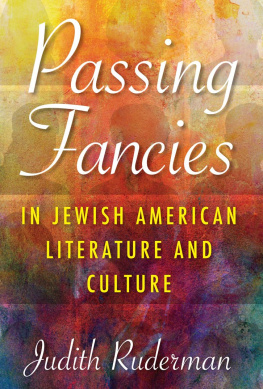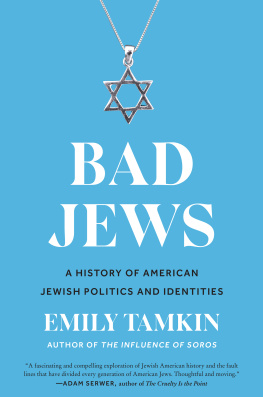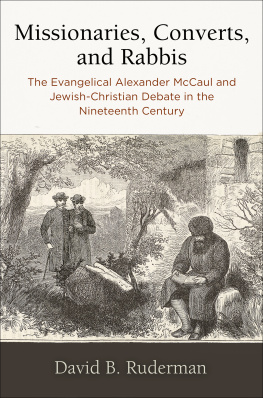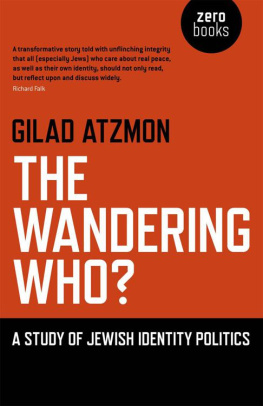Contents
Guide
I THANK THE ARTISTS in words or images who created the texts that inspired my work and the many scholars who produced my secondary sources: the literary critics, Judaic studies experts, researchers on race and passing, sociologists, medical historians, biographers, physiciansthe list goes on.
Various friends and family members suggested works relevant to my topic or made other helpful comments: Dorothy Anger, David Birnbaum, Linda Carl, Susan Dyer, Lawrence Etter, John Friedman, Laura Lieber, Eric Meyers, B. J. Purow, Sarah Purow-Ruderman, Marjory Ruderman, and Diane Sasson. They were an important part of this process, personally and professionally, and I am grateful for their interest and input.
Thanks to Dee Mortensen, the humanities editor at Indiana University Press, for being warmly receptive to my initial proposal; Alvin Rosenfeld, the editor of the series of which my book is now a part; and various others at the press, including Paige Rasmussen and Maya Bringe, who responded to my technical questions or cleaned up my errors. My experience from proposal to publication has only reinforced my prior impression of IUPs reputation. I was fortunate that the anonymous readers of my manuscript accepted the task of reviewing it, for they gave my work considerable care and attention and offered invaluable advice as a result. I wish I could thank them in person for their time, energy, knowledge, and intelligence, but here at least I can acknowledge these unnamed scholars for the critical insights that improved this book immeasurably.
At Duke I relied on the IT expertise of Quincy Garbutt, who responded to my computer issues with alacrity and patience. My research and writing were facilitated by the dedicated staff and extensive holdings of the Duke University Library. I so appreciate the assistance of Dukes librarians, especially Jewish Studies specialist Rachel Ariel and literature and theater studies specialist Arianne Hartsell-Gundy, but also those who provided additional needed services, often behind the scenes: Bobbi Earp, Erin Nettifee, Cheryl Thomas, and many more. I am lucky to have access to the breadth and depth of the holdings not only of Duke University but also of the other research libraries in the area and beyond, whose resources I tapped as well. As but one example of the materials available to me, Duke has a complete set of the years issues of the Smart Set that I was looking forthis in spite of the fact that, as Thomas Connolly said of the magazine, in his study of its co-editor George Jean Nathan, the periodical files... have almost completely deteriorated. It is one of the scarcest of magazines.
Finally, I am grateful for the opportunity to have taught at Duke over many years in addition to my administrative posts, and I particularly thank the students in my Duke University seminars on Jewish American literature and culture. Although I had long been interested in this broad subject, it was in these classes that I was able to develop that interest from a passing fancy into an actual book. Above and beyond the opportunity to test ideas in a classroom of bright undergraduates, my students enthusiasm for the authors and issues we discussed increased my own. I hope they got from those classes half of what they gave to me.
JUDITH RUDERMAN is Visiting Scholar of English at Duke University. She is the winner of the 2017 Harry T. Moore Award for lifetime contributions to D. H. Lawrence studies and author of four previous books, including Race and Identity in D. H. Lawrence: Indians, Gypsies, and Jews.
Aarons, Victoria. Philip Roths Comic Realism in Goodbye, Columbus. In Playful and Serious: Philip Roth as a Comic Writer, edited by Ben Siegel and Jay L. Halio, 3546. Newark: University of Delaware Press, 2010.
Aarons, Victoria, Avinoam J. Patt, and Mark Shechner. Introduction to The New Diaspora: The Changing Landscape of American Jewish Fiction, edited by Victoria Aarons, Avinoam J. Patt, and Mark Shechner, 118. Detroit: Wayne State University Press, 2015.
Ackerman, Diane. The Zookeepers Wife: A War Story. New York: W. W. Norton, 2007.
Alexander, Michael. Jazz Age Jews. Princeton, NJ: Princeton University Press, 2001.
Alexander, Michael, and Bruce D. Haynes. The Color Issue: An Introduction. In American Jewish History 100, no. 1 (January 2016): two unnumbered pages before page 1.
American Society of Plastic Surgeons. Plastic Surgery Statistics 2017. https://www.plasticsurgery.org/news/plastic-surgery-statistics/
Austerlitz, Saul. The Hidden One of N. J.: Why Dara Horn Is the Best of the New Breed of Jewish Novelists. Tablet, September 9, 2013. http://www.tabletmag.com/jewish-arts-and-culture/books/143707/dara-horn-profile.
Baker, Cynthia M. Jew. New Brunswick, NJ: Rutgers University Press, 2017.
Barkan, Elazar. The Retreat of Scientific Racism: Changing Concepts of Race in Britain and the United States between the World Wars. Cambridge: Cambridge University Press, 1992.
Baum, Charlotte, Paula Hyman, and Sonya Michel. The Jewish Woman in America. New York: Dial Press, 1976.
Bell, Vikki. Mimesis as Cultural Survival. In Performativity and Belonging, edited by Vikki Bell, 13362. London: SAGE Publications, 1999.
. Performativity and Belonging: An Introduction. In Performativity and Belonging, edited by Vikki Bell, 110. London: SAGE Publications, 1999.
Belzer, Tobin. On Being a Jewish Feminist Valley Girl. In Yentls Revenge: The Next Wave of Jewish Feminism, edited by Danya Ruttenberg, 18188. Seattle: Seal Press, 2001.
Benor, Sarah Bunin. Becoming Frum: How Newcomers Learn the Language and Culture of Orthodox Judaism. New Brunswick, NJ: Rutgers University Press, 2012.
Bloom, Lisa E. Jewish Identities in American Feminist Art: Ghosts of Ethnicity. New York: Routledge, 2006.
Blum, Virginia L. Flesh Wounds: The Culture of Cosmetic Surgery. Berkeley: University of California Press, 2003.
Blyth, Myrna. Cousin Suzanne. New York: Mason/Charter, 1975.
. Spin Sisters: How the Women of the Media Sell Unhappinessand Liberalismto the Women of America. New York: St. Martins Press, 2004.
Blythe, Will. Innocents Lost. Review of The Ministry of Special Cases, by Nathan Englander. New York Times, June 3, 2007. Book Review. www.nytimes.com/2007/06/03/books/review/Blythe-t.html?_r=2&.
Bock, Charles. The Russian Midlife Crisis Handbook. New York Times, August 14, 2016, 15. Book Review.
Bodner, Allen. Boxing: A Jewish Sport. My Jewish Learning. http://www.myjewishlearning.com/article/boxing-a-jewish-sport/.
Bolton-Fasman, Judy. The Original Jewish Princess and I. Forward, June 5, 2015, 46.
Briquelet, Kate. Watch Out, Rachel Dolezal. Theres Another White NAACP Leader. The Daily Beast, June 15, 2015. http://www.thedailybeast.com/articles/2015/06/15/watch-out-rachel-dolezal-there-s-another-white-naacp-leader.html.
Bristow, Edward J. Prostitution and Prejudice: The Jewish Fight against White Slavery 18701939. New York: Schocken Books, 1983.
Brodesser-Akner, Taffy. Apostates Anonymous. New York Times Magazine, April 2, 2017, 3641.
Brodkin, Karen. How Jews Became White Folksand May Become Nonwhite under Trump. Forward, December 6, 2016. http://forward.com/opinion/356166/how-jews-became-white-folks-and-may-become-nonwhite-under-trump/.
. How Jews Became White Folks and What That Says about Race in America. New Brunswick: Rutgers University Press, 1998.
Broom, Leonard, Helen P. Beem, and Virginia Harris. Characteristics of 1,107 Petitioners for Change of Name. American Sociological Review 20, no. 1 (February 1955): 3339.
Next page





